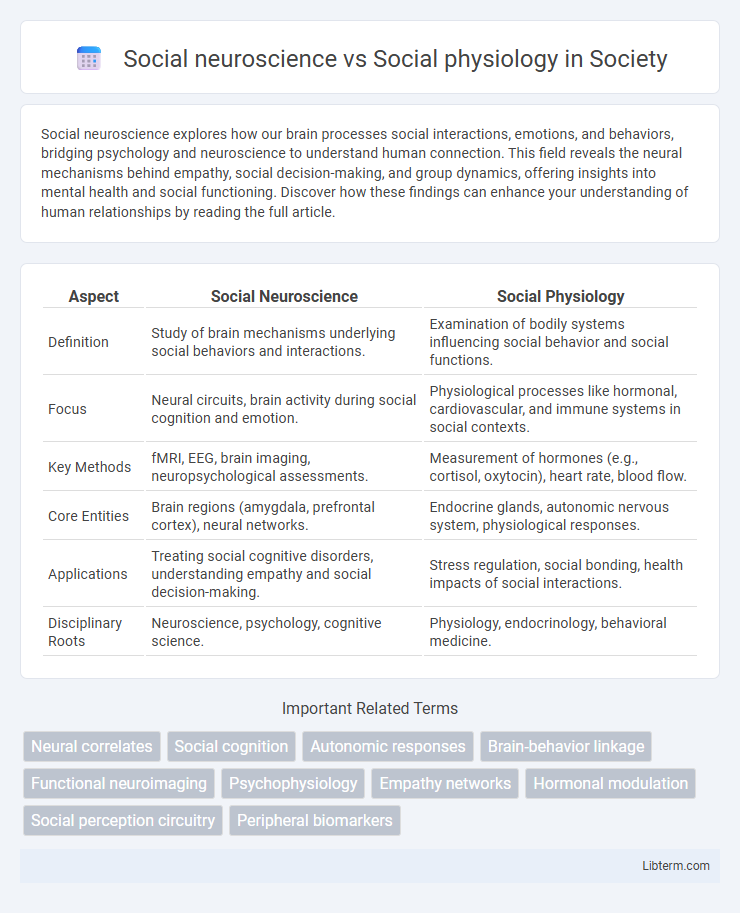Social neuroscience explores how our brain processes social interactions, emotions, and behaviors, bridging psychology and neuroscience to understand human connection. This field reveals the neural mechanisms behind empathy, social decision-making, and group dynamics, offering insights into mental health and social functioning. Discover how these findings can enhance your understanding of human relationships by reading the full article.
Table of Comparison
| Aspect | Social Neuroscience | Social Physiology |
|---|---|---|
| Definition | Study of brain mechanisms underlying social behaviors and interactions. | Examination of bodily systems influencing social behavior and social functions. |
| Focus | Neural circuits, brain activity during social cognition and emotion. | Physiological processes like hormonal, cardiovascular, and immune systems in social contexts. |
| Key Methods | fMRI, EEG, brain imaging, neuropsychological assessments. | Measurement of hormones (e.g., cortisol, oxytocin), heart rate, blood flow. |
| Core Entities | Brain regions (amygdala, prefrontal cortex), neural networks. | Endocrine glands, autonomic nervous system, physiological responses. |
| Applications | Treating social cognitive disorders, understanding empathy and social decision-making. | Stress regulation, social bonding, health impacts of social interactions. |
| Disciplinary Roots | Neuroscience, psychology, cognitive science. | Physiology, endocrinology, behavioral medicine. |
Introduction to Social Neuroscience and Social Physiology
Social neuroscience explores the neural mechanisms underlying social behaviors by integrating psychology, neuroscience, and biology to study brain activity associated with social interactions. Social physiology examines physiological processes such as hormonal regulations, autonomic nervous system responses, and cardiovascular function that influence social behavior and emotional responses. Both disciplines advance understanding of social behavior through different biological levels, with social neuroscience focusing on brain processes and social physiology emphasizing bodily functions.
Defining Social Neuroscience
Social neuroscience explores the neural underpinnings of social behaviors, integrating brain imaging, cognitive science, and psychology to understand how social interactions influence brain function. It examines mechanisms such as empathy, social cognition, and neural networks involved in processing social information. In contrast, social physiology primarily focuses on the body's systemic responses, including hormonal and autonomic processes, during social engagement and stress.
Defining Social Physiology
Social physiology examines the biological and physiological processes underlying social behaviors, emphasizing neural, hormonal, and genetic mechanisms that regulate group interactions and social dynamics. In contrast, social neuroscience integrates psychological and neuroscientific methods to study how brain function influences social cognition and behavior. Defining social physiology involves understanding its focus on systemic bodily functions, such as endocrine and autonomic responses, in shaping social relationships and collective behavior.
Historical Development of Both Fields
Social neuroscience emerged in the late 20th century, integrating neuroscience techniques with social psychology to explore brain mechanisms underlying social behavior, with pioneers like Uta Frith and John Cacioppo contributing to its foundation. Social physiology, rooted in early 20th-century work, studies the biochemical and hormonal basis of social interactions, tracing back to research on oxytocin and cortisol's role in social bonding and stress responses. Both fields have evolved through interdisciplinary collaboration, but social neuroscience emphasizes neural circuits and imaging, while social physiology focuses on physiological processes and endocrine responses.
Core Research Methods in Social Neuroscience
Core research methods in social neuroscience primarily include neuroimaging techniques such as functional magnetic resonance imaging (fMRI), electroencephalography (EEG), and magnetoencephalography (MEG), which allow for the examination of brain activity during social interactions. In contrast to social physiology, which emphasizes hormonal assays and autonomic nervous system measures like heart rate and skin conductance, social neuroscience focuses on mapping neural correlates underlying social cognitive processes. Behavioral experiments combined with neurophysiological recordings provide insights into how brain regions like the amygdala, prefrontal cortex, and temporoparietal junction contribute to empathy, social decision-making, and group dynamics.
Core Research Methods in Social Physiology
Social physiology employs core research methods such as neuroimaging techniques like fMRI and PET scans to measure physiological responses during social interactions, providing insights into autonomic nervous system activity, hormone analysis, and cardiovascular monitoring. These methods capture real-time changes in body systems linked to social behavior, emphasizing the physiological mechanisms underpinning social processes. In contrast, social neuroscience primarily integrates neural and cognitive perspectives, focusing more on brain activity patterns rather than broader systemic physiological responses.
Key Findings in Social Neuroscience
Social neuroscience reveals how brain structures like the amygdala and prefrontal cortex regulate social behaviors, emotions, and decision-making processes. Functional MRI studies identify neural correlates of empathy, trust, and social cognition, emphasizing the role of mirror neurons and the default mode network. Key findings highlight how neural plasticity adapts to social environments, impacting mental health outcomes and social functioning.
Key Findings in Social Physiology
Social physiology reveals how physiological systems, such as the autonomic nervous system and endocrine responses, regulate social behavior and emotional states. Key findings highlight the role of hormonal influences like oxytocin in promoting social bonding and cortisol in stress responses during social interactions. Studies demonstrate how physiological synchrony between individuals enhances social cohesion and communication effectiveness.
Overlapping Areas and Interdisciplinary Insights
Social neuroscience and social physiology intersect in exploring how social behaviors influence brain function and bodily systems, emphasizing neural mechanisms and physiological responses such as hormone regulation and autonomic nervous activity. Both fields utilize techniques like neuroimaging, hormonal assays, and behavioral analysis to understand social interactions' impact on mental and physical health outcomes. Interdisciplinary insights reveal how social environments trigger neuroendocrine responses, shaping cognition, emotional states, and social behaviors through integrated brain-body communication pathways.
Future Directions and Applications
Social neuroscience explores brain mechanisms underlying social behavior, leveraging neuroimaging and neurophysiological tools to map social cognition. Future directions include integrating genetic and epigenetic data to personalize interventions in mental health disorders such as autism and social anxiety. Social physiology emphasizes systemic bodily processes like neuroendocrine and autonomic functions, with applications advancing wearable biosensors to monitor social stress and optimize real-time behavioral therapies.
Social neuroscience Infographic

 libterm.com
libterm.com